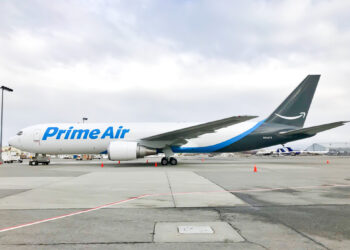No products in the cart.
Runaway e-commerce growth reshaping air freight: Part II

Today, we conclude our two-part analysis of the ways in which surging demand from e-commerce is changing how participants across the air freight supply chain operate, and what the future of air freight in a logistics world built around e-commerce might look like. Part II examines how e-commerce marketplaces are making moves toward offering their own logistics services, and how airports are addressing new infrastructure requirements to meet e-commerce shopper expectations of rapid deliveries. Read part I here for insights into what qualifies as e-commerce, which trade routes are emerging as the major drivers in e-commerce traffic, and how carriers are working together, or with other partners, to meet growing demand.
While part I of our e-commerce analysis looked at partnerships developed by air cargo carriers, of course, not all emerging e-commerce partnerships involve carriers. Many smaller e-commerce players and other digital platforms are forging new partnerships or making acquisitions in an effort to carve out market share before Amazon or Alibaba can do so.
Walmart’s acquisition of India’s Flipkart, for example, could help the brick-and-mortar retail giant make inroads into the budding Indian e-commerce market. As Business Insider India reports, e-commerce sales in India currently make up only about 3% of total retail sales, while the market is also the fastest-growing in the Asia Pacific region after China and Indonesia. At about US$17 billion, the investment by Walmart is substantial, but given the growth potential of India’s e-commerce market, the potential payoff could rocket Walmart into the upper echelons of the e-commerce hierarchy.
Other partnerships feature e-commerce players with an already substantial footprint in the market. China’s JD.com has a large presence in the domestic Chinese market, and also recently partnered with tech giant Google to develop new e-commerce products and services for global markets, including in Southeast Asia, the US, and Europe. In the partnership, Google will invest US$550 million in JD.com, which will, in turn, issue discounted Class A shares to Google.
While Google has not traditionally been a significant e-commerce player, the partnership with JD does offer the search engine giant an opportunity to expand its shopping platform and increase the product searches that begin on Google, thus giving it a greater ability to extract ad revenue from searches. JD.com, meanwhile, may gain significant ground through this partnership, by offering its products for sale in the US, Europe, and Southeast Asia markets through Google Shopping, and by employing Google’s investment to further optimize its supply chain.
Sorting out e-commerce
Although carriers have thus far succeeded in adding freighters to support growing e-commerce volumes, airports still struggle to find space to sort out what all of those parcels and space to develop needed infrastructure is not always easy to come by. Verhasselt told Cargo Facts that Liège has addressed this issue with what he called the “Liège Logistics Park,” an off-airport, third-line logistics park that has plenty of warehouse space for parcel sorting.
While Verhasselt said he envisions the park eventually evolving to function similarly to a postal facility, with advanced sorting capabilities to facilitate growing e-commerce parcel volumes, the logistics park currently looks basically like a regular warehouse with lots of space to sort the pallets. As he told Cargo Facts, “the less you automate it, the more space you need, so I think now it’s more about space and, in the future, when they really come to sort, I believe we will be able to decrease the need for space.”
Ontario Airport also has a large amount of space available for development – about 700 acres, in fact, Mark Thorpe, CEO of the Ontario International Airport Authority, told Cargo Facts. The airport will likely need that space, given that cross-border e-commerce at the airport is growing by about 50% per year, with Amazon Air expected to operate fifteen flights per day into the airport by the fall – up from only one daily flight two years earlier.
Infrastructure growth for combination carriers has been slow-going at the airport, though. While FedEx inked a deal in June extending its long-term lease at ONT for at least another thirty years, integrators like FedEx can secure much of their own infrastructure and handling operations. But combination carriers need additional investments from airports to support their operations. Thorpe said ONT eventually hopes to add multi-tenant warehouses at the facility, but added that those are still in conceptual phases, and serious discussions are not yet underway. Still, he said that the airport hopes to make an announcement soon regarding development plans at ONT. As with the broader e-commerce logistics chain, the airport has plenty of room to grow.
Learn more about e-commerce and its impact on demand for freighter aircraft 10-12 October at Cargo Facts Symposium, where a roundtable panel discussion will be dedicated to the topic. For more information, or to register, visit www.cargofactssymposium.com.




